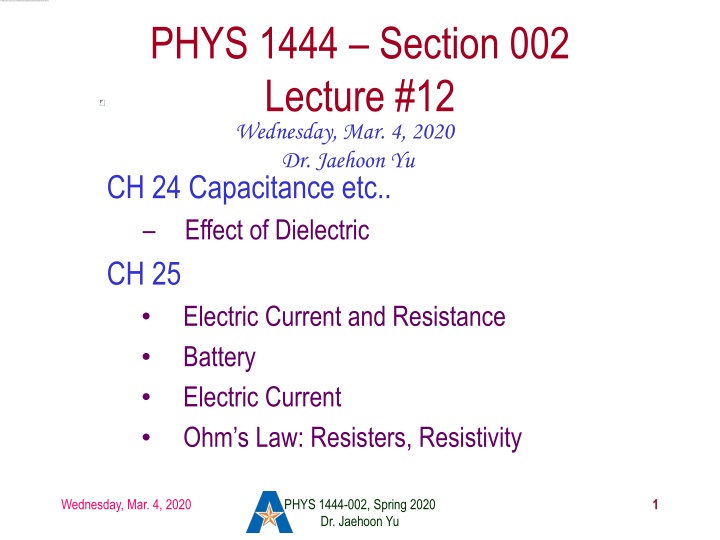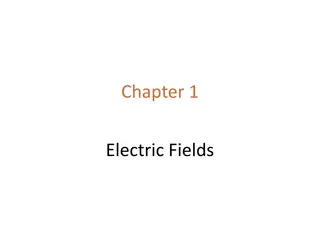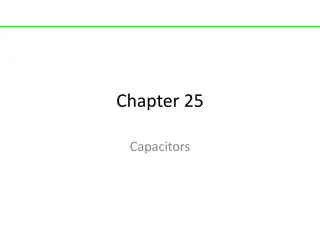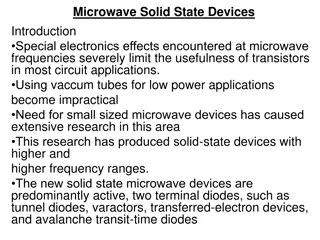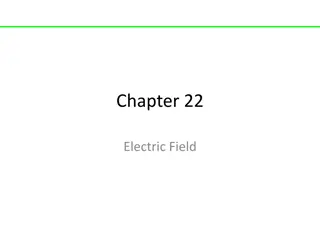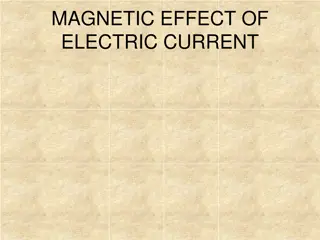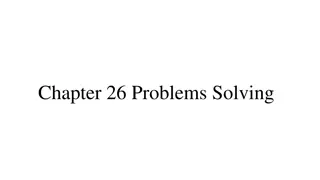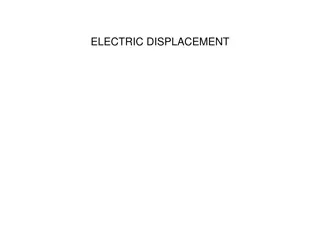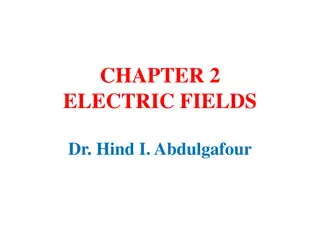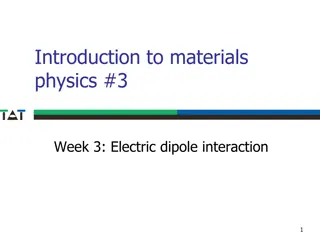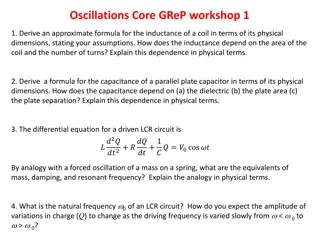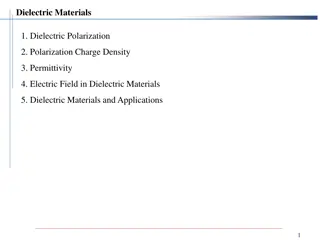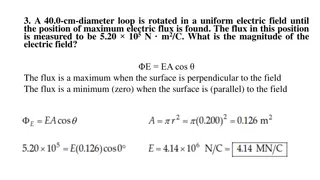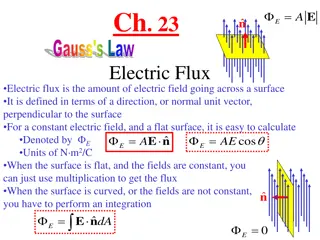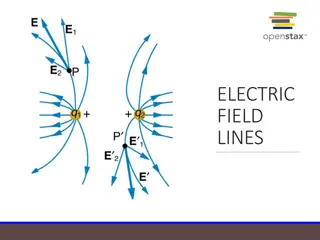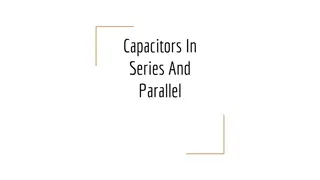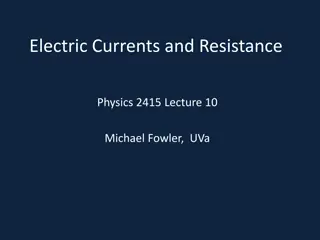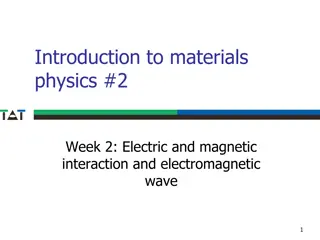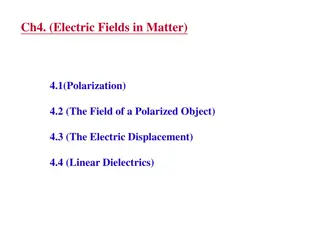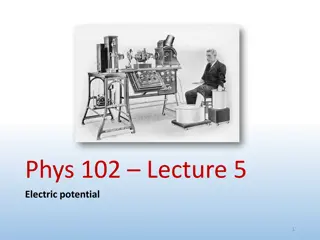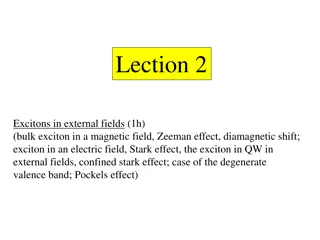Effect of Dielectric Materials on Capacitance and Electric Field
The impact of dielectric materials on capacitance and electric field in a parallel-plate capacitor, covering concepts like constant voltage and charge, field strength, energy storage, and more. Understand how inserting and removing dielectrics affect these properties. Discover the calculations involved in determining capacitance, charge, electric field strength, and stored energy with dielectrics. Enhance your understanding of capacitors and their behavior with dielectric materials.
Download Presentation

Please find below an Image/Link to download the presentation.
The content on the website is provided AS IS for your information and personal use only. It may not be sold, licensed, or shared on other websites without obtaining consent from the author.If you encounter any issues during the download, it is possible that the publisher has removed the file from their server.
You are allowed to download the files provided on this website for personal or commercial use, subject to the condition that they are used lawfully. All files are the property of their respective owners.
The content on the website is provided AS IS for your information and personal use only. It may not be sold, licensed, or shared on other websites without obtaining consent from the author.
E N D
Presentation Transcript
PHYS 1444 Section 002 Lecture #12 Wednesday, Mar. 4, 2020 Dr. Jaehoon Yu CH 24 Capacitance etc.. Effect of Dielectric CH 25 Electric Current and Resistance Battery Electric Current Ohm s Law: Resisters, Resistivity Wednesday, Mar. 4, 2020 PHYS 1444-002, Spring 2020 Dr. Jaehoon Yu 1
Announcements Mid-term Exam Wednesday, Mar. 18 at the beginning of the class Covers CH21.1 through what we finish Monday, Mar. 16 Bring your calculator but DO NOT input formula into it! Cell phones or any types of computers cannot replace a calculator! BYOF: You may bring a one 8.5x11.5 sheet (front and back) of handwritten formulae and values of constants for the quiz No derivations, word definitions or solutions of any problems! No additional formulae or values of constants will be provided! Reminder for a triple extra credit colloquium 4pm Wednesday, Mar. 18 Dr. Pedro Machado of Fermilab Wednesday, Mar. 4, 2020 PHYS 1444-002, Spring 2020 Dr. Jaehoon Yu 2
Effect of a Dielectric Material on Capacitance Let s consider the two cases below: Case #1 : constant V Case #2 : constant Q Constant voltage: Experimentally observed that the total charge on each plate of the capacitor increases by K as a dielectric material is inserted between the gap Q=KQ0 The capacitance increased to C=Q/V0=KQ0/V0=KC0 Constant charge: Voltage found to drop by a factor K V=V0/K The capacitance increased to C=Q0/V=KQ0/V0=KC0 Wednesday, Mar. 4, 2020 PHYS 1444-002, Spring 2020 Dr. Jaehoon Yu 3
Effect of a Dielectric Material on Field What happens to the electric field within a dielectric? Without a dielectric, the field is What are V0 and d? V0: Potential difference between the two plates d: separation between the two plates For a constant voltage, the electric field remains the same For the constant charge: the voltage drops to V=V0/K, thus the field in the dielectric is The field in the dielectric is reduced. E E = V d 0 = E 0 V dK E K V d 0 0 = = = = E E D 0 Wednesday, Mar. 4, 2020 PHYS 1444-002, Spring 2020 Dr. Jaehoon Yu K 4 D
Example 24 11 Dielectric Removal: A parallel-plate capacitor, filled with the dielectric of K=3.4, is connected to a 100-V battery. After the capacitor is fully charged, the battery is disconnected. The plates have area A=4.0m2 and are separated by d=4.0mm. (a) Find the capacitance, the charge on the capacitor, the electric field strength, and the energy stored in the capacitor. (b) The dielectric is carefully removed, without changing the plate separation nor does any charge leave the capacitor. Find the new value of capacitance, electric field strength, voltage between the plates and the energy stored in the capacitor. 2 K A A =( ) 4.0 m (a) C = 0 = 12 2 2 8 3.4 8.85 10 N m = 3.0 10 = 30 C F nF 3 d d CV =( V d 1 2CV = 4.0 10 m ) Q = 8 6 3.0 10 = 3.0 10 = 100 3.0 F V C C 100 V 4 = 2.5 10 = E = V m ( 3 4.0 10 m )( 13.0 10 2 ) 2 U = 2 8 4 = 1.5 10 100 F V J Wednesday, Mar. 4, 2020 PHYS 1444-002, Spring 2020 Dr. Jaehoon Yu 5
Example 24 11 contd (b) Since the dielectric has been removed, the effect of dielectric constant must be removed as well. C K 4.0 10 2 =( ) 4.0 m C = 12 2 2 9 N m = 8.8 10 = 8.85 10 8.8 C F nF 0 3 m = Q Q Since charge is the same ( ) before and after the removal of the dielectric, we obtain 0 V = 0 Q C = KQ C = KV = 3.4 100 V d 4.0 10 m 1 2C V = 2 K 0 = 340 V V 340 V 4 E = = 8.5 10 = 0 = 84 V m kV m 0 3 1 1 2KCV = KU = C ( ) 2 U = 2 2 = KV 4 4 3.4 1.5 10 = 5.1 10 J J 0 0 0 Wrong! Wrong! Wrong! The energy conservation law is violated in electricity??? Where did the extra Wednesday, Mar. 4, 2020 energy come from? PHYS 1444-002, Spring 2020 Dr. Jaehoon Yu 6 An external force has done the work of 3.6x10-4J on the system to remove dielectric!!
Molecular Description of Dielectric So what in the world makes dielectrics behave the way they do? We need to examine this in a microscopic scale. Let s consider a parallel plate capacitor that is charged up +Q(=C0V0) and Q with air in between. Assume there is no way any charge can flow in or out Now insert a dielectric Dielectric can be polar could have permanent dipole moment. What will happen? Due to the electric field molecules will be aligned. Wednesday, Mar. 4, 2020 PHYS 1444-002, Spring 2020 Dr. Jaehoon Yu 7
Molecular Description of Dielectric OK. Then what happens? Then effectively, there will be some negative charges close to the surface of the positive plate and positive charge on the negative plate Some electric field do not pass through the whole dielectric but stops at the negative charge So the field inside dielectric is smaller than the air Since electric field is smaller, the force is smaller The work need to move a test charge inside the dielectric is smaller Thus the potential difference across the dielectric is smaller than across the air Wednesday, Mar. 4, 2020 PHYS 1444-002, Spring 2020 Dr. Jaehoon Yu 8
Electric Current and Resistance So far we have been studying static electricity What is the static electricity? The charges so far has not been moving but staying put at the location they are placed. Now we will learn dynamics of electricity What is the electric current? A flow of electric charge A few examples of the things that use electric current in everyday lives? In an electrostatic situation, there is no electric field inside a conductor but when there is current, there is field inside a conductor. Why? Electric field is needed to keep charges moving Wednesday, Mar. 4, 2020 PHYS 1444-002, Spring 2020 Dr. Jaehoon Yu 9
The Electric Battery What is a battery? A device that produces electrical energy from the stored chemical energy and produces electricity Maintains potential difference! Electric battery was invented by Volta in late 1790s in Italy It was made of disks of zinc and silver w/ salt-water soaked clothes based on his research that certain combinations of materials produce a greater electromotive force (emf), or potential, than others Piles (or a battery) of these connected to make up the first battery! Simplest batteries contain two plates made of dissimilar metals called electrodes Electrodes are immersed in a solution, the electrolyte This unit is called a cell and many of these form a battery Zinc and Iron in the figure are called terminals Wednesday, Mar. 4, 2020 PHYS 1444-002, Spring 2020 Dr. Jaehoon Yu 10
How does a battery work? I One of the electrodes in the figure is zinc and the other carbon The acid electrolyte reacts with the zinc electrode and dissolves it. Each zinc atom leaves two electrons in the electrode and enters into the solution as a positive ion Zinc electrode acquires negative charge and the electrolyte (the solution) becomes positively charged The carbon electrode picks up the positive charge Since the two terminals are oppositely charged, there is a potential difference between them Wednesday, Mar. 4, 2020 PHYS 1444-002, Spring 2020 Dr. Jaehoon Yu 11
How does a battery work? II When the terminals are not connected, only the necessary amount of zinc is dissolved into the solution. How is a particular potential maintained? If the terminals are not connected, as too many of zinc ion gets produced, zinc electrode gets increasingly charged up negative zinc ions get recombined with the electrons in zinc electrode Why does battery go dead? When the terminals are connected, the negative charges will flow away from the zinc electrode More zinc atoms dissolve into the electrolyte to produce more charge One or more electrode get used up not producing any more charge. Wednesday, Mar. 4, 2020 PHYS 1444-002, Spring 2020 Dr. Jaehoon Yu 12
Electric Current When a circuit is powered by a battery (or a source of emf) the charge can flow through the circuit. Electric Current: Any flow of charge Current can flow whenever there is a potential difference between the ends of a conductor (or when the two ends have opposite charges) The current can flow even through the empty space under certain conditions Electric current in a wire can be defined as the net amount of charge that passes through the wire s full cross section at any point per unit time (just like the flow of water through a conduit.) Average current is defined as: The instantaneous current is: What kind of a quantity is the current? Unit of the electric current? I = DQ Dt I = dQ dt C/s 1A=1C/s Scalar In a single circuit, conservation of electric charge guarantees that the current Wednesday, Mar. 4, 2020 at one point of the circuit is the same as any other points on the circuit. PHYS 1444-002, Spring 2020 Dr. Jaehoon Yu 13
Example 25 1 Current is a flow of charge: A steady current of 2.5A flows in a wire for 4.0min. (a) How much charge has passed by any point in the circuit? (b) How many electrons would this be? Current is total amount charge flown through a circuit in a given time. So from we obtain Q = I t 2.5 4.0 60 600C = = = Q I t The total number of electrons passed through the circuit is 600 Q e C 21 = N = = 3.8 10 electrons e 19 1.6 10 C How many electrons per second does 2.5A corresponds to? Wednesday, Mar. 4, 2020 PHYS 1444-002, Spring 2020 Dr. Jaehoon Yu 14
